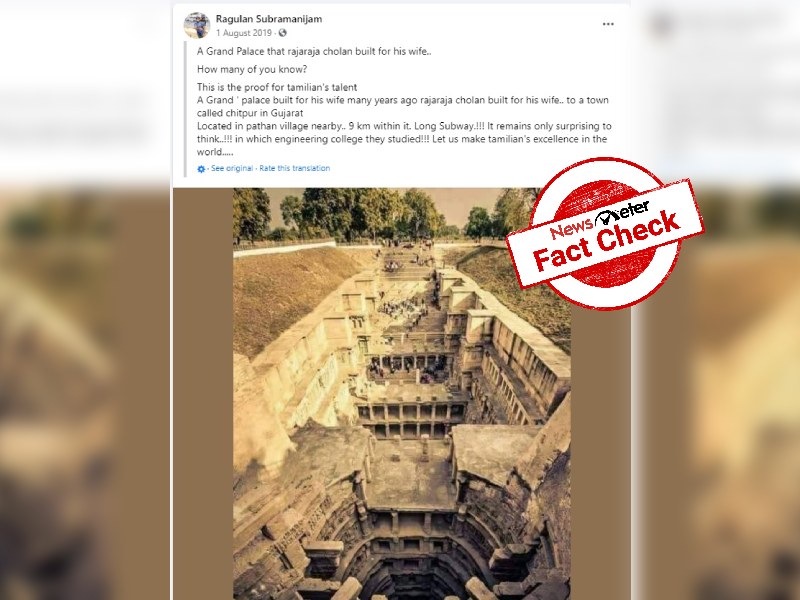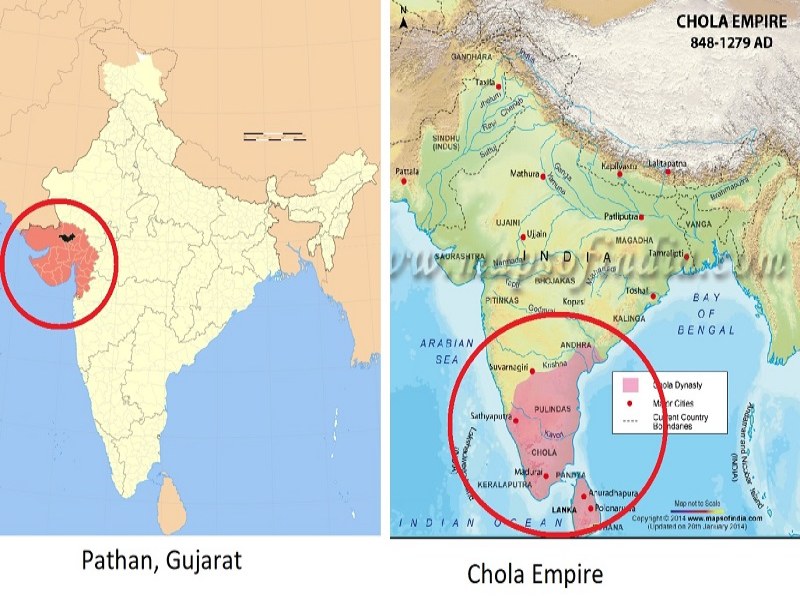Fact check: Picture showing ancient well with amazing Indian architecture is NOT built by Rajaraja Chola
By Satya Priya BN
Hyderabad: A picture showing an ancient well with amazing Indian architecture, is going viral with Tamil claim that it is 'A grand palace that Rajaraja Chola built for his wife. How many of you know? This is the proof for Tamilian's talent.
A grand palace built for his wife many years ago rajaraja cholan built for his wife.. to a town called Chitpur in Gujarat. Located in Pathan village nearby.. 9 km within it. Long Subway.!!! It remains only surprising to think..!!! in which engineering college they studied!!! Let us make tamilian's excellence in the world.'
Archived versions of the claims are here and here.
Fact Check:
The claim that the monument seen in viral messages was built by Rajaraja Chola is FALSE.
When searched using Google Reverse image, NewsMeter could confirm that this structure was called Rani ki Vav and is located on the banks of the Saraswati river, in the town of Pathan, Gujarat. Rani ki Vav, a step-well in the little Gujarat town of Patan, features on the new Rs 100 note. It was also declared a UNESCO World Heritage site in 2014.
According to UNESCO.org, Rani ki Vav was built at the height of craftsmens' ability in step-well construction and the Maru-Gurjara architectural style, reflecting mastery of this complex technique and great beauty of detail and proportions.
Designed as an inverted temple highlighting the sanctity of water, it is divided into seven levels of stairs with sculptural panels of high artistic quality; more than 500 principle sculptures and over a thousand minor ones combining religious, mythological and secular imagery, often referencing literary works.
It was built by Queen Udayamati more than 950 years ago in memory of her husband King Bhimdev I (1022-63) of the Solanki dynasty. That is how the step-well got its name 'Rani ki Vav'. It means Queen's step-well in Gujarati. It was built between 1063-1068 AD in the Maru-Gurjara architectural style while the Cholas are popular for the Dravidian architechtural style.
An article published in Britannica.com, popular king among Medieval Chola kings, Raja Raja I (reigned 985–1014), an able administrator, protected Vengi (the Godavari districts) and occupied the Gangavadi territory (in present-day Karnataka state), annihilating the western Gangas. By 996, he had conquered Kerala (the Chera country) and acquired northern Sri Lanka. He built the great Brihadishvara temple at Tanjore (now Thanjavur). By 1014, Rajaraja had acquired the Lakshadweep and Maldive islands.
The Cholas continued the temple-building traditions of the Pallava dynasty and contributed significantly to the Dravidian temple design. They built numerous temples throughout their kingdom such as the Brihadeshvara temple. Aditya-I built a number of Siva temples along the banks of the river Kaveri. Those temples ranged from small to medium scale until the end of the 10th century.
Airavateswarar Temple, Darasuram c. 1200. Temple building received great impetus from the conquests and the genius of Rajaraja Chola and his son Rajendra Chola I (r. 1014 C.E.). The maturity and grandeur to which the Chola architecture had evolved found expression in the two temples of Tanjavur and Gangaikondacholapuram.
The magnificent Siva temple of Thanjavur, completed around 1009, stands as a fitting memorial to the material achievements of the time of Rajaraja. The largest and tallest of all Indian temples of its time, the temple sits at the apex of South Indian architecture.
Here are the maps showing the location of Pathan, Gujarat and area of Chola Dynasty Empire.

Therefore, the claims that the monument seen in the images shared was NOT built by Raja Raja Chola but by Rani Udayamati more than 950 years ago in memory of her husband King Bhimdev I (1022-63) of the Solanki dynasty. Raja Raja Chola built many amazing temples in Dravidian architechtural style like Brihadeeshwara temple, Airavateswara temple in Tamil Nadu.
Hence, the claim is FALSE.